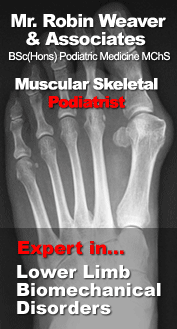 Frequently Asked Questions
Frequently Asked Questions
What are orthotics?
Podiatrists prescribe and construct foot orthotics. These
are specially designed devices that are worn inside the shoe
in order
to control abnormal foot function and/or accommodate painful
areas of the foot. Properly designed foot orthotics compensate
for impaired foot function by controlling abnormal motion
across the joints of the foot. This results in a dramatic
improvement/resolution in symptoms.
Functional foot orthotics are usually made from rigid
materials, especially plastics and carbon-fibre composites.
They are constructed upon a plaster impression of the feet,
and modified based on the podiatrist's evaluation of the
problem. They are usually quite comfortable, and do not feel hard or uncomfortable
in the shoe.
Rigid orthotics normally last for years; additions such as
top covers and extensions may require periodic replacement.
Some patients, for example the very elderly, may not tolerate
rigid functional orthotics. Under these circumstances, the
podiatrist may prescribe an orthotic made from softer materials
with special accommodations for painful areas.
Many different materials can be utilized, such as rubber,
cork, leather, and soft synthetic plastics. The podiatrist
is in the unique position of being able to evaluate, diagnose,
and treat your foot or leg problems. If orthotics are indicated,
he or she can utilize the most advanced methods of construction.
Orthotics which are prescribed by the podiatrist and custom
made for your feet, should not be confused with 'over the counter'
arch supports. These may occasionally help with minor arch
discomfort, but they frequently fail because they do not
properly control foot function and/or do not properly fit the
patient's feet and on occasion exacerbate the problem.
The consumer should beware that there are individuals with
no or inadequate training, that masquerade as experts on foot problems
and orthotics. Only Podiatrists or a medical
doctors or in some circumstances Orthotists can diagnose and manage foot and leg problems. In the
U.K. the term Podiatrist is a legally protected title, however
in the authors view the law is not adequately enforced and
many people illegally call themselves a Podiatrist.
...............................
 top
of page
top
of page
 ............................
............................
What are Functional
Posted Foot Orthotics?
Functional posted orthotics control
abnormal position and movement of the foot. While standing
or walking the heel and midfoot are held in a more stable
position. This allows the foot to function more efficiently
during weight-bearing and propulsion.
This control is often accomplished by limiting abnormal
pronation of the foot. Pronation is a complex movement involving
eversion (turning out) of the heel and forefoot. There is
a corresponding internal rotation (turning in) of the lower
leg, and flattening of the arch. Ligaments become strained,
and muscles over-work attempting to pull the foot into a more
stable position.
By controlling abnormal pronation, functional orthotics help
to
prevent some of the complications of the chronically unstable
foot. Functional orthotics are usually (but not always) made
from rigid plastic materials. There may be various additions,
top covers, and extensions, depending on the patient's needs.
They are very comfortable, as they are custom made from plaster
impressions.
The posts on functional orthotics are wedges at the heel
and midfoot, which hold those structures in a proper angular
relationship to each other and the leg. Functional posted
orthotics should only be prescribed by a properly trained
State registered Podiatrist and only after a through
biomechanical examination has been conducted.
...............................
 top
of page
top
of page
 ............................
............................
Will orthotics correct
my foot problem?
Orthotics will control the position and motion of your foot.
This may prevent the development of pain and disability, and
the development of additional deformity. Orthotics will not
change the underlying structure of the adult foot. If they
are not worn, abnormal function will immediately return. In
a sense they are analogous to glasses, if you remove then
you can no longer see properly.
...............................
 top
of page
top
of page
 ............................
............................
Will orthotics fit
in all my shoes?
Some shoes will not fit properly
with an orthotic inside. These are usually dressy shoes with
a shallow heel counter (i.e. the rear part of the shoe that
wraps around the heel). Women have more fitting problems than
men, due to shoe fashion.
It is possible find dress shoe that nicely accomodate an orthotic, but
choices will be more limited. There are special dress shoe
orthotics that fit more easily into fashionable shoes. Discuss
with your podiatrist if these are suitable for you.
...............................
 top
of page
top
of page
 ............................
............................
After wearing my orthotics,
my legs and back were sore. Is this normal?
Some people develop discomfort in the foot, leg, or lower
back when they first start to wear orthotics. This is normal
and is due to a realignment of the whole lower extremity and
pelvis. Muscles and ligaments have to readjust to this new
alignment. 80% of patients will
experience intermittent moderate aches and pains. Which typically
disappear after two or three weeks.
...............................
 top
of page
top
of page
 ............................
............................
Are special orthotics
required for sports?
Standard orthotics are appropriate for most activities, including
sports which do not involve excessive impact on the feet.
Other sports such as running, basketball, high impact
aerobics, tennis, racquet sports, and golf all involve
considerable ground impact and require 'sport specific'
orthotics.
Sports orthotics are fabricated from more resilient materials
which dissipate some of this force. They are available in
a variety of forms, general purpose and those designed for
the demands of a specific sport.
|

